Preserved Lemons
This post may contain affiliate links. See my disclosure policy.
Get ready to unlock one of the grand secrets of Moroccan and Middle Eastern cuisine by learning how to make preserved lemons in this step-by-step tutorial. These homemade preserved lemons are a powerhouse ingredient that will infuse your dishes with such an incredible flavor and absolutely transform any dish you add them to, whether savory or sweet. Just a few minutes of your time will give you this magical ingredient that keeps for months and you can enjoy all the year through!
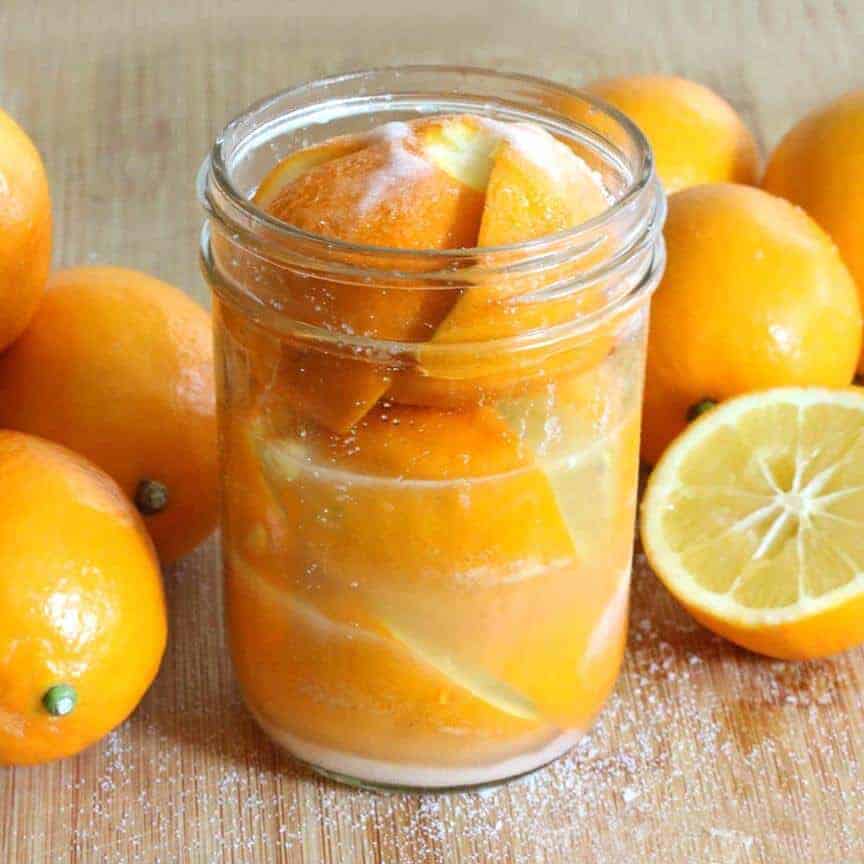
If you’re a fan of Moroccan and Middle Eastern cooking you’ve probably had the experience of thumbing through recipes, drooling all the while, earmarking the ones you particularly like, only to then scan through the ingredients and see the words: “Preserved Lemons”. Your heart sinks for a moment as you realize you are sorely lacking this crucial ingredient. And so with disappointment you un-earmark that page and move on to the next recipe. DON’T let that scenario stop you again. Because nothing could be easier than making your own DIY preserved lemons! These are one of my most favorite “secret” ingredients and I’m going to show you exactly how to make them and how to use them in lots of delicious ways!
What Are Preserved Lemons?
Preserved lemons are lemons that have been packed in salt and their own juices and are left to cure for about a month. During that time the flavors transform in which the acidic tartness disappears and you’re left with a very amplified and complex lemon flavor. Think of preserved lemons as lemons on steroids. They add an intense, concentrated lemon flavor to the dish without all the sour tartness. The preserving process tempers the tartness while accentuating the lemon flavor. In other words, mildly tart but intensely lemony. And if you’re a lover of all things lemon, preserved lemons need a permanent place in your pantry. I can assure you, there is virtually always a jar of these in my fridge!
This preservation process also extends the shelf life of the lemons and they’ll keep for around 6 months in your fridge and even longer if you can them. Over time the lemons become soft and to use them you simply remove however much you need, scrape off the fleshy interior, rinse off the peel, dice it up, and add it to your dishes. Preserved lemons have been around for centuries and are used extensively in Middle Eastern and North African cuisines, most famously Moroccan food. Their unique flavor adds an incredible amount of flavor to a wide variety of savory dishes and desserts.
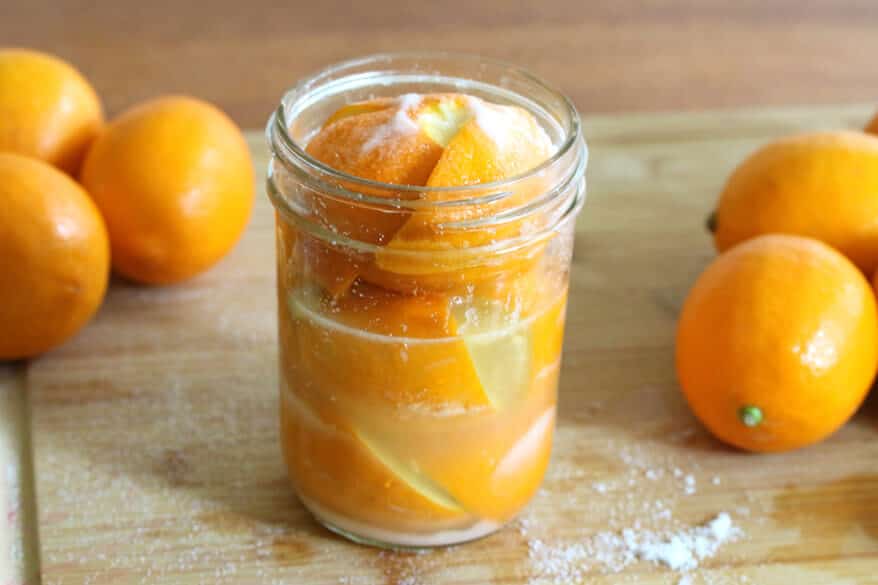
How to Use Preserved Lemons
You’ll find preserved lemons called for in a lot of Middle Eastern and Moroccan recipes, everything from tagines to stews and salads and add a uniquely tangy, salty, and mildly sweet flavor. They can be added to any dish that calls for or can benefit from a touch of lemon flavor. And that includes desserts. Here are just a few ways to use preserved lemons:
- Tagines and stews: a little goes a long way to adding life and flavor. Try them in my Moroccan Harira and Moroccan Chicken Tagine. They’re also great in a variety of bean stews and lentil soups.
- Chicken, duck, beef, lamb, pork, and fish: preserved lemons pair beautifully with any protein. Try them in my Moroccan Chicken (Djej Makalli). And of course lemon and seafood are soulmates. Now just wait until you’ve paired it with preserved lemons and your life is forever changed.
- Salads: Finely mince and toss them into your salads, including pasta salads. They also pair beautifully with grain salads and grain bowls. Try them in two of my personal favorites, this Moroccan Chicken Salad and Curried Couscous Salad.
- Rice, grain, and pasta dishes: try them in my Salmon Risotto – it’s a match made in heaven.
- Marinades: Incorporate them into marinades for chicken, lamb, pork and fish. They add just touch of acidity and a whole depth of flavor.
- Dressings, sauces and dips : Blend them into dressings, vinaigrettes and sauces for an exciting flavor punch. They also work really well in creamy sauces. Add some to your Hummus or Baba Ganoush or to some Greek yogurt along with fresh dill for a refreshing dip.
- Sandwiches and Wraps: you can even add them to your burgers for a fun flavor boost. Oh, and add them to Falafel!
- Salsas and Relishes: chop some up and it to your salsas and relishes for a unique lemony twist like my Mango Salsa and Pineapple Salsa.
- Roasted Vegetables: Toss your roasted veggies with some butter and finely minced preserved lemons for a fabulous flavor. They pair particularly well with root vegetables and cauliflower.
- Cakes, Cupcakes, Muffins, etc: Anything that you would add lemon zest to, try adding some finely minced preserved lemon. Try it in our Preserved Lemon and Ginger Pound Cake.
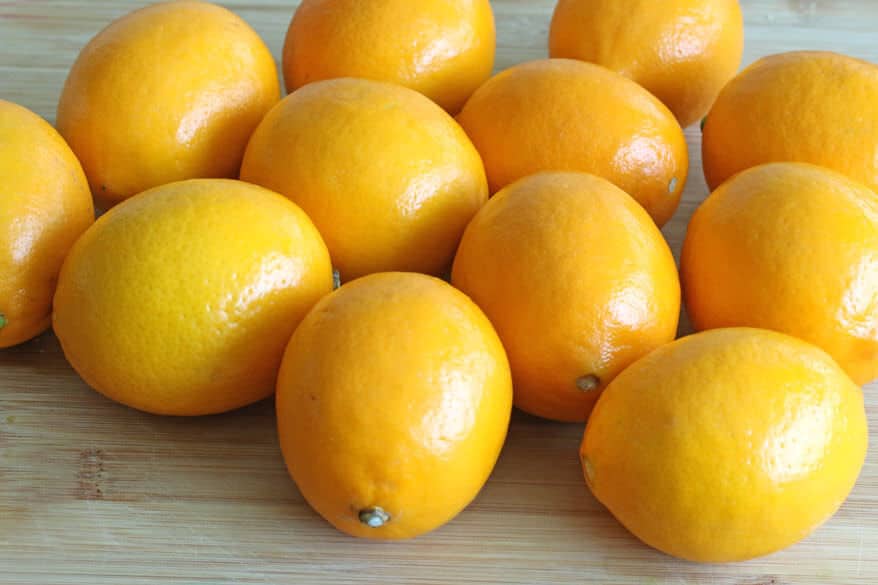
What Kind of Lemons Are Best?
Doqq and boussera lemons are commonly used in Morocco. They have thinner skins and are sweeter than regular lemons. A great substitute is Meyer lemons. If you can’t find Meyer lemons you can use regular lemons such as Eureka or Lisbon. Organic is ideal since it’s the lemon rinds that are eaten.
Variations
Did you know, you can also make preserved limes, oranges, grapefruit and kumquats! The process is identical but because high acidity is required for proper preservation and other citrus varieties have a lower acid content, you will still need to top off the jars with lemon juice. Experiment with these other citrus varieties for some fun flavor variations.
How Long Do Preserved Lemons Last?
Preserved lemons can be stored at room temperature but they’ll ferment very quickly that way and won’t keep as long. It’s recommended to store them in the fridge, in a glass jar with a lid, where they will keep for up to 6 months, and quite possibly longer. Just check periodically for any signs of mold or off colors and smells.
Preserved Lemons Recipe
Let’s get started!
Organic is ideal if you can find them since it’s the rinds that are eaten. If you can’t find organic, let the lemons soak in a vinegar-water solution for a few minutes to clean the outer peels, then rinse.
Trim the nubs off both ends of each lemon.
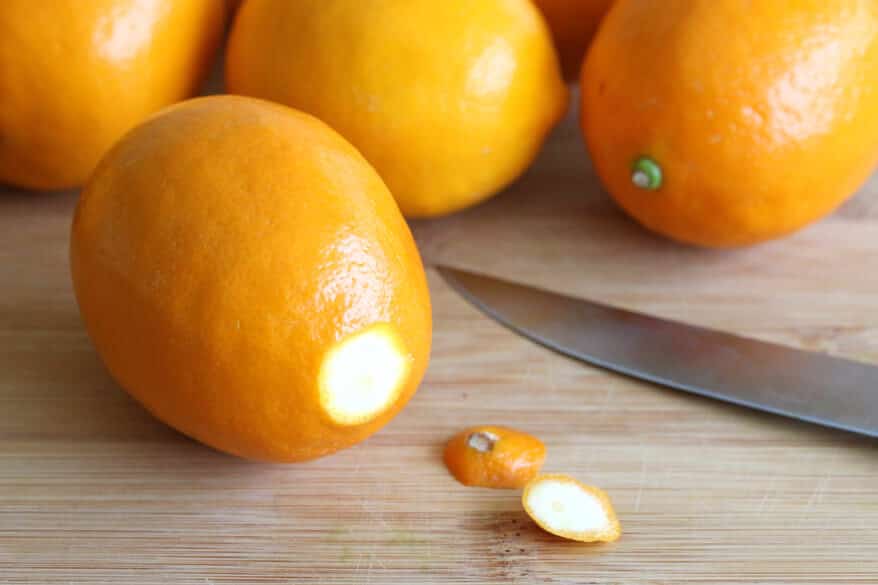
Slice the lemons into quarters, leaving the ends attached. So slice down just a little over 3/4 of the way.
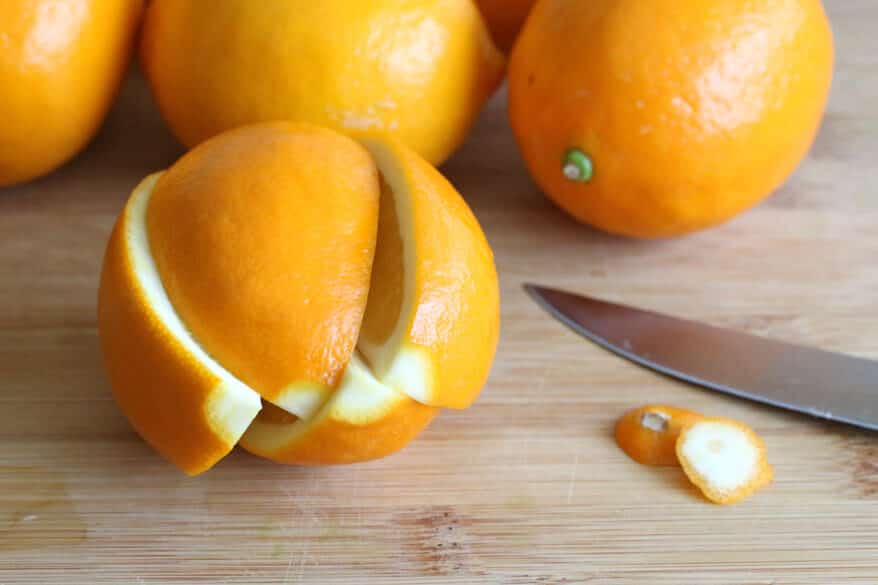
Put a teaspoon of salt in the bottom of a pint-sized jar. Put another teaspoon of salt into the quartered lemon.
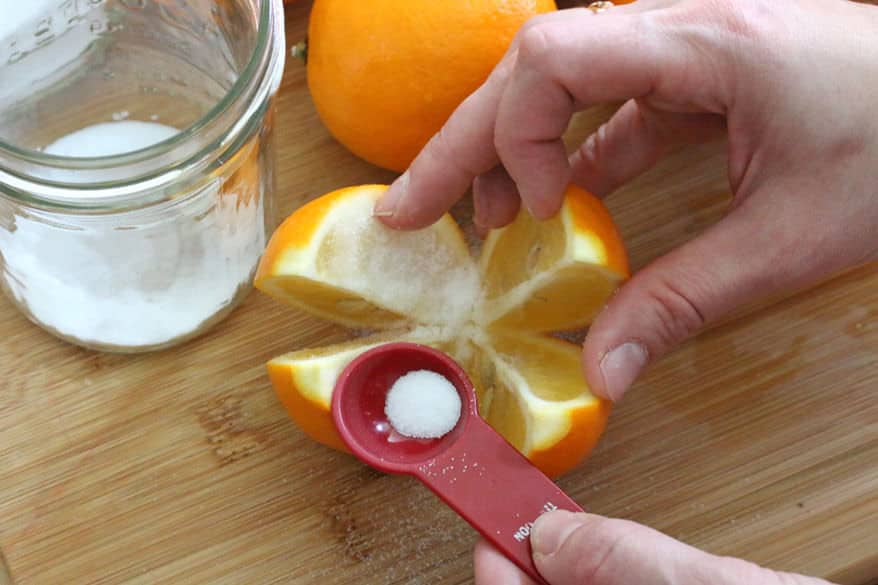
Stuff the lemon into the jar, open end down, and push hard to squish it and release its juices.
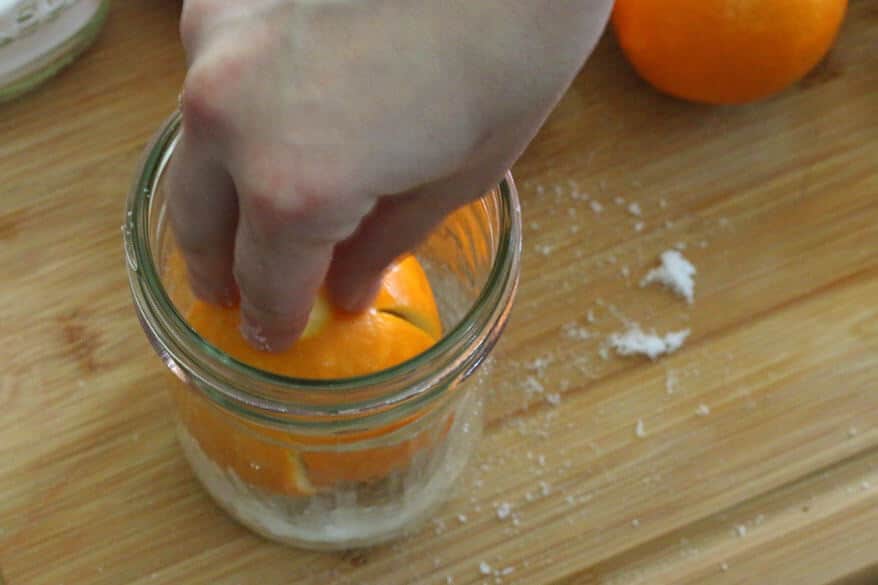
Put a teaspoon of salt over the top of the lemon.
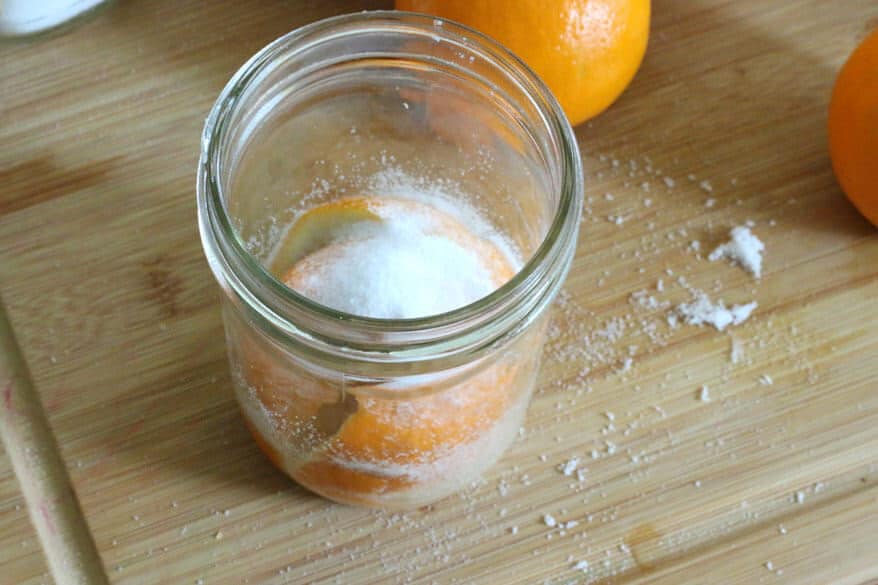
Repeat the process, putting a teaspoon of salt inside the second lemon, and then squish it down hard on top of the first lemon.
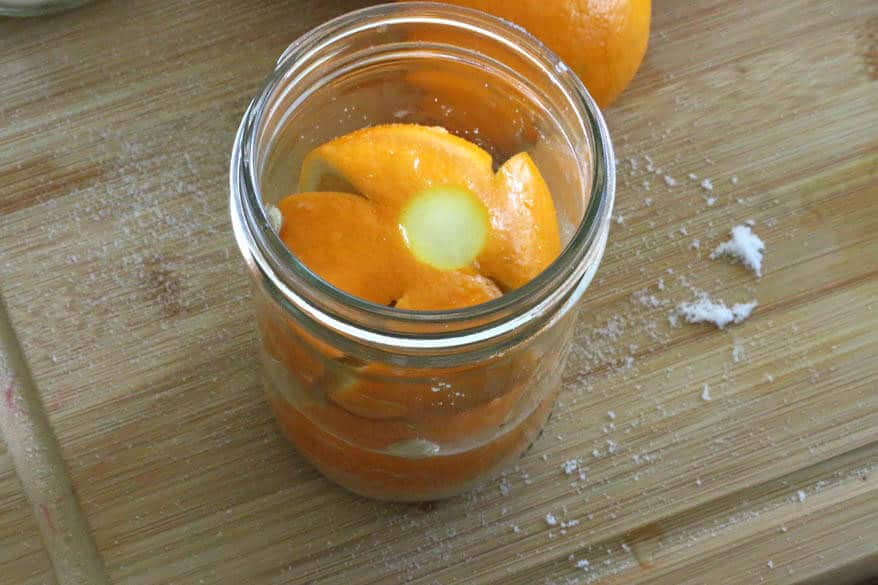
You got it – add another teaspoon of salt on top of the second lemon, and repeat the process for the third and final lemon. Add a teaspoon of salt on the very top. The jar should be at least halfway full of lemon juice from having compressed the lemons. If needed, squeeze some extra lemon juice into the jar to bring it to the halfway point. And don’t waste that lemon – cut it up and stuff it into the jar. Now pour some water that’s been boiled and cooled (sterile) into the jar to fill it up the rest of the way. Repeat this process for however many jars you wish to make.
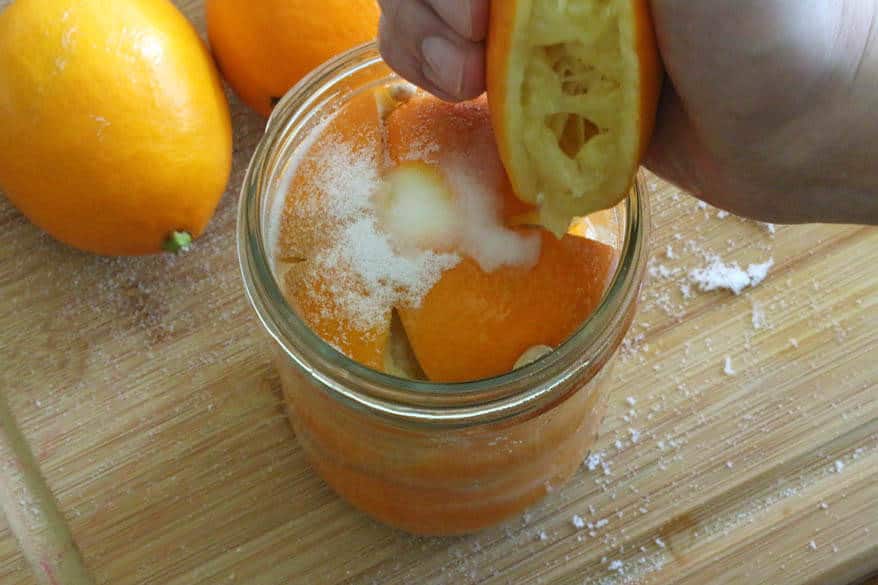
After you add the water, screw on the lid and let the jar sit at room temperature for 3 days, giving it a shake and turn it upside-down/right-side up a few times a day. After 3 days place the jar in the refrigerator and let it sit for at least 3 weeks before using. Keep the jar in the refrigerator. Whatever dish you use them in, discard the pulp (it’s the peel that is used) and thoroughly wash the peel to remove excess salt.
That’s it! Your preserved lemons are ready! *Taste bud choir breaks out into a stirring rendition of the “Hallelujah Chorus”*
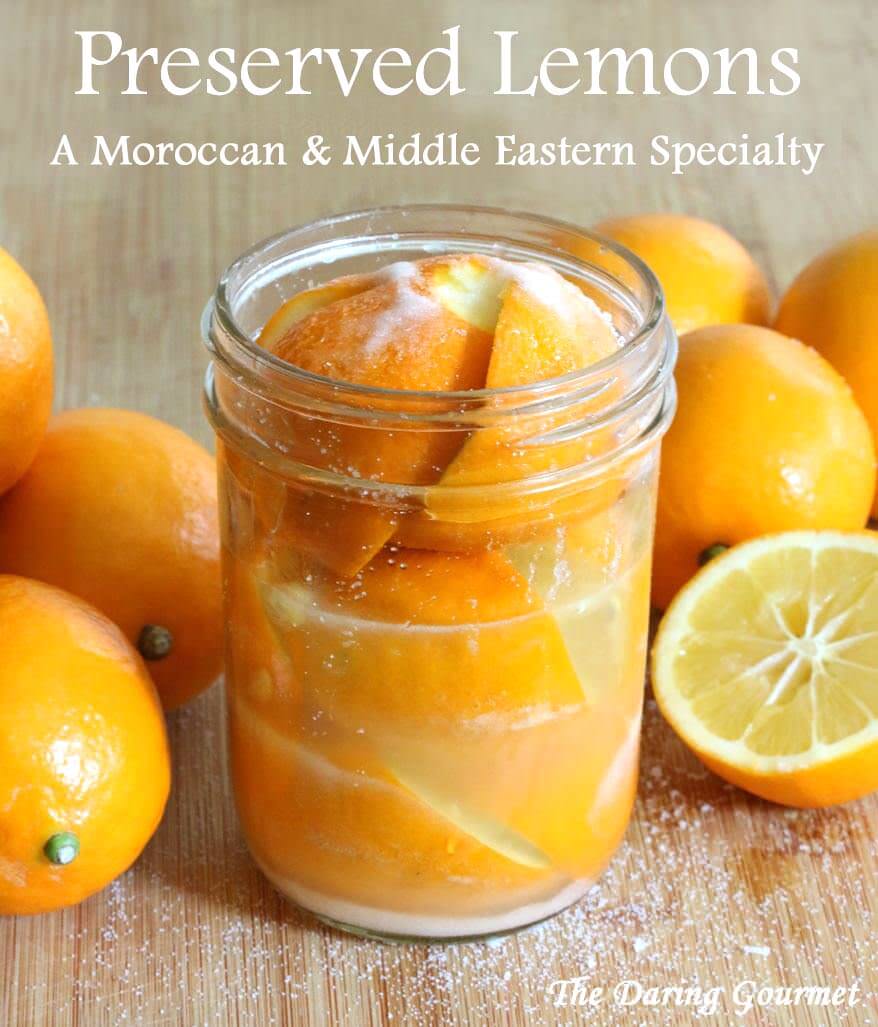
Save This Recipe

Preserved Lemons
Ingredients
- 3 Meyer lemons , or Eureka, Lisbon, etc, organic recommended per pint-sized jar
- 5-6 teaspoons sea salt or kosher salt (regular table salt contains iodine which will turn the lemons gray)
- An extra lemon for juicing
- Water that has been boiled and cooled sterile
Instructions
- Note: you can make however many preserved lemons you like, but roughly 3 will fit per pint-sized jar.Thoroughly clean the lemons. Organic is recommended. If you can't find organic, let the lemons sit in some vinegar water for a few minutes, then rinse.Trim the nubs off both ends of each lemon. Quarter each lemon, slicing them down just over 3/4 of the way to leave the slices attached at the end.Put one teaspoon of salt into the cavity of each lemon.Place one teaspoon salt into the bottom of the jar. Put a lemon in the jar, cut-side down, pressing firmly to squish out the lemon juice. Put a teaspoon of salt on top of the lemon. Firmly press the second lemon down on top of the first lemon. Repeat with the third lemon, pressing down firmly. Add a teaspoon of salt on top of the lemon.The jar should be at least halfway full with lemon juice. If needed, squeeze some additional lemon juice into the jar to bring it to the halfway point. Don't waste that lemon; slice it and stuff the slices into the jar. Pour the boiled/cooled water into the jar to fill it to the top.Screw the lid on and let it sit at room temperature for 3 days, shaking it and rotating the jar upside-down/right-side up a few times per day. After 3 days transfer the jars to the refrigerator and let them sit for at least 3 weeks before using. Stored in the fridge, they will keep for at least 6 months (see note).
Notes
* Whatever dish you use them in, discard the pulp (it’s the peel that is used) and thoroughly wash the peel to remove excess salt. * Using other citrus: You can also make preserved limes, oranges, grapefruit and kumquats! The process is identical but because high acidity is required for proper preservation you will still need to top off the jars with lemon juice.
Nutrition
Originally published on The Daring Gourmet April 8, 2014



















it actually doesnt even look like salt. if it was a good salt it wouldn’t look like powdered sugar or whatever. it’s probably a stock photo? But anyway, i meant what i said about Himalayan Salt. It is not as healthy as everyone wants to think. Don’t let the name fool you. It is full of sand.. It will tear up the cilia in the intestinal lining. I found out by adding this salt to my soup and i felt the sand. So i dissolved the salt in hot water and drained off the water. There was a HUGE amount of sand in my pan.. So I did some research.. Himalayan salt is a FRAUD and it is totally unhealthy/unfit for consumption
but anyway… I am TOTALLY looking forward to making preserved lemons with your recipe!! My friends want me to also make them some.. WIll keep you posted. Im sure they will turn out as wonderful as they look :D
Kelly, I can assure you that it’s salt and that the pictures are not stock photos, they’re mine :) I certainly don’t relish the idea of eating a bunch of sand. I don’t use Himalayan salt but I think I have a package of it lying around somewhere – I’ll need to conduct the same experiment.
Have fun making these preserved lemons – they’re going to WOW you once they’re ready and you start adding them to food.
strangely enough Ive had some recent issues with himalayan salt. I’ve found tiny pieces of what i thought was glass, but may very well have been sand. I’d decided I wasnt going to purchase it anymore. I may try the celtic if I can find it. Its so typical of stores and companies to jump on the latest fad and make the cheapest version of it. :(
It really is typical, Lisa, and frankly so much of these speciality salts are little more than marketing hype. Even if some of the salts are touted for their nutritional properties, it is in such tiny, tiny trace amounts that there’s no benefit to using it unless you’re eating it by the truckload – something you wouldn’t want to do anyway :) Special finishing salts served over a finished meal like fleur de sel are one thing, but for cooking I personally stick with sea salt and kosher salt.
Instead of using the crap Morten salt that Americans are known to use (and what is pictured above) why not try Celtic Sea Salt.
Also,Himalayan is lower quality. It isn’t really from the Himalayas. Its from Pakistan 900 mi away but they called it Himalayan because it sounds better. There is also a HUGE amt of SAND in “Himalayan” salt which tears up the intestinal tract..
Pictured above? Where? I’m not sure what you’re referring to, Kelly. I don’t use Morten salt simply because it isn’t ideal for preserving.
Can I use pink Himalayan salt for preserved lemons?
Hi Rachael, yes, pink Himalayan salt is a great choice.
I put on 3 jars of these this morning. We live in Andes here in Ecuador, and the Meyer lemons down here grow to baseball size. I had to cut them lengthwise then cut a notch out of the middle so they would kind of bend to get them in my jars. I look forward to seeing how these turn out. Thanks for offering this recipe.
Wow, that’s incredible, Lynne! I wish you could send a huge box of them to me :) I just made another batch myself last week and am patiently waiting for them to be ready. Let us know once you’ve tried them in a dish!
Greetings from Washington State!!
I found your website and let me first say…. Thanks!!! I’m super grateful!!! I’ve tried several of your recipes and I am impressed by all of them! Thank you for keeping it fun, real and easy to follow! I’ve always been a foody and enjoy seeing others get into the kitchen and make magic happen…
Cheers!
Hi Sarah! Greetings to WA from WA! :) I’m so thrilled to hear you’ve tried and enjoyed several recipes, thank you so much and I look forward to “seeing” you around here at The Daring Gourmet! Best, Kimberly
I just remembered a bag of lemons in the back of my fridge which are starting to get old a little wrinkled. Do you think they would be OK to preserve?
Hi Shirley, I’d recommend using them for things that call for lemon juice, not the rind. Preserved lemons use only the rind and in preserving them you’ll want to use fresh lemons.
Kimberly, I made preserved lemons some time ago and i do have a Trajan. I have not used for some time so i will get into this again.
I have Meyer lemon tree and i juice lots of lemons i freeze the juice for lemonade. i was thinking that when i juice so many lemons why i can’t put the peels into jars, add salt and lemon juice? i would be able to get a lot more peels in the jars that way. Do you foresee any problems doing it that way? I don’t see any importance of using the pulp as it’s discarded anyway.
Thanks.
Hi Darr, I think that rationale is perfectly sound, as long as you’re adding extra lemon juice that would otherwise have come from the pulp inside the lemons. With as many lemons as you go through that’s the perfect way to put the rinds to excellent use. Plus, you’ll have a lot of jars on hand you can use for great hostess gifts. Happy preserving!
You could always do candied lemon peel….cook in sugar water then let dry and roll in sugar. Perfect for the holidays, I start to save all of my peels, lemon, lime, grapefruit, etc leading up to the holidays. Also if you have a lot of lemons, try limoncello, its amazing.
I finally used my lemons after eagerly waiting for 6 weeks and OMG they really are incredible!! I made your Moroccan chicken with olives and the flavor of these lemons in it is out of this world. I can’t wait to try more of your recipes using preserved lemons (and many others). Thank you so much for this great step by step tutorial with pictures on how to make preserved lemons, it was easy and I’ll be making them again and again because they are amazing!
Yayyy! I’m glad your patience paid off, Kris, and really appreciate the feedback, thank you!
How lovely! I really liked preserved lemons but have never made my own. It’s so easy, this must change!
These look really easy to make. What am I waiting for?
I’ve never cooked with Preserved lemons and had no idea to make them! They look pretty easy though.
I’ve been meaning to try this for a long time. Thanks for showing the way!
Preserved lemons are something that I’ve had on my “must make” list for years (literally, like 10), and yet…I still haven’t done it. Thanks for the reminder, these look so bright and sunny!
These look just beautiful! I happen to love preserved lemons, but have never made them myself.
I’ve heard of preserved lemons before but I have to admit, I knew nothing about them. Thanks for all this info.